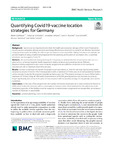Quantifying Covid19-vaccine location strategies for Germany
Leithäuser, Neele
Schneider, Johanna
Johann, Sebastian
Krumke, Sven O.
Schmidt, Eva
Streicher, Manuel
Scholz, Stefan
Background: Vaccines are an important tool to limit the health and economic damage of the Covid-19 pandemic.
Several vaccine candidates already provided promising effectiveness data, but it is crucial for an effective vaccination
campaign that people are willing and able to get vaccinated as soon as possible. Taking Germany as an example, we
provide insights of using a mathematical approach for the planning and location of vaccination sites to optimally
administer vaccines against Covid-19.
Methods: We used mathematical programming for computing an optimal selection of vaccination sites out of a
given set (i.e., university hospitals, health department related locations and general practices). Different
patient-to-facility assignments and doctor-to-facility assignments and different constraints on the number of
vaccinees per site or maximum travel time are used.
Results: In order to minimize the barriers for people to get vaccinated, i.e., limit the one-way travel journey (airline
distance) by around 35 km for 75% of the population (with a maximum of 70 km), around 80 well-positioned facilities
can be enough. If only the 38 university hospitals are being used, the 75% distance increases to around 50 km (with a
maximum of 145 km). Using all 400 health departments or all 56 000 general practices can decrease the journey
length significantly, but comes at the price of more required staff and possibly wastage of only partially used vaccine
containers.
Conclusions: In the case of free assignments, the number of required physicians can in most scenarios be limited to
2 000, which is also the minimum with our assumptions. However, when travel distances for the patients are to be
minimized, capacities of the facilities must be respected, or administrative assignments are prespecified, an increased
number of physicians is unavoidable.
Dateien zu dieser Publikation

